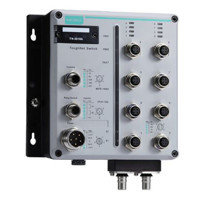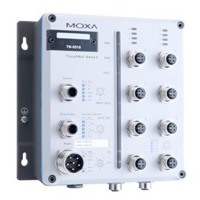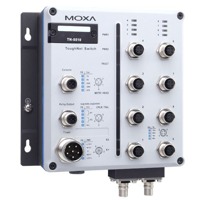TN-5510A-2GLSX-ODC - Managed M12 Ethernet Switches
The ToughNet TN-5510A-2GLSX-ODC and TN-5510A-8PoE-2GLSX-ODC series M12 managed Ethernet switches are designed for railway applications, such as rolling stock and wayside installations. The TN series switches use M12 and other circular connectors to ensure tight, robust connections, and guarantee reliable operation against environmental disturbances, such as vibration and shock. In addition, the 24 to 110 VDC wide power input range and isolated power inputs not only allow you to use the same type of power source at different sites around the globe, but also increase the reliability of your communications system. The TN-5510A-2GLSX-ODC and TN-5510A-8PoE-2GLSX-ODC switches provide up to 8 Fast Ethernet M12 ports, and 2 ports on the down side to provide the Gigabit fiber interface with an embedded 2-km multimode fiber transceiver.
The TN-5510A-8PoE-2GLSX-ODC series Ethernet switches have 8 Fast Ethernet M12 ports with 8 IEEE 802.3at/af compliant PoE (Power-over-Ethernet) ports. The PoE switches are classified as power source equipment (PSE); they provide up to 30 watts of power per port, and can be used to power IEEE 802.3at/af compliant powered devices (PDs), such as IP cameras, wireless access points, and IP phones. Moreover, the -40 to 75°C operating temperature and IP54-rated waterproof enclosure allow deployment in harsh environments. The TN-5500A series Ethernet switches are compliant with essential sections of EN 50155, covering operating temperature, power input voltage, surge, ESD, and vibration, as well as conformal coating and power insulation, making the switches suitable for a variety of industrial applications.
Improving Efficiency of Inter-Consist Communications Using Auto-Negotiations
Because train carriages and consists are frequently reconfigured, the speed and accuracy with which new inter-carriage and inter-consist links can be established are both key determinants in the overall operational efficiency of a railway operation. For this, auto-negotiation is a substantial time-saver, but it is also complicated to implement on networks that use more sophisticated networking technologies such as ring redundancy topology or wireless bridges. This white paper describes how modern railway solution providers have developed auto-negotiation strategies for both Layer 2 (communication-level) and Layer 3 (operations-level) networks






